The Systems Change for Sustainable Tech is a 3-part co-creation series that invites everyone who is interested to use systems thinking to build a sustainable tech future. Together, we will envision a sustainable future for technology, map our current situation using systems maps (causal loop diagrams), identify key leverage points for impactful change, design effective interventions, and create action plans to bridge the gap between our vision and today’s reality. This article recaps the third part of the “Systems Change for Sustainable Tech” series. Systems changemakers from around the world gathered to revisit the vision for sustainable tech, map the current reality of unsustainable tech; identify leverage points; design interventions to reduce the gap between the vision and current reality.
On Thursday, June 19th, the CAT community gathered for the third installment of our series, Systems Change for Sustainable Tech. The series introduced how systems thinking can be used to map the current reality using causal loop diagrams, identify leverage points, and design fundamental solutions. The purpose behind the series was to provide a space where participants can:
- Build a shared vision to make tech sustainable.
- Learn and apply systems thinking to map current reality and identify the leverages where interventions will give maximum benefit.
- Co-create effective interventions to reduce the gap between the vision and current reality.
During this session, we revisited the fundamentals of systems thinking and collaboratively explored two systems change projects. We explored the potential of mindful technology integration and the power of technology to drive equity and well-being. For each project, we built an iceberg model, created causal loop diagrams, identified key leverage points, and designed fundamental interventions.
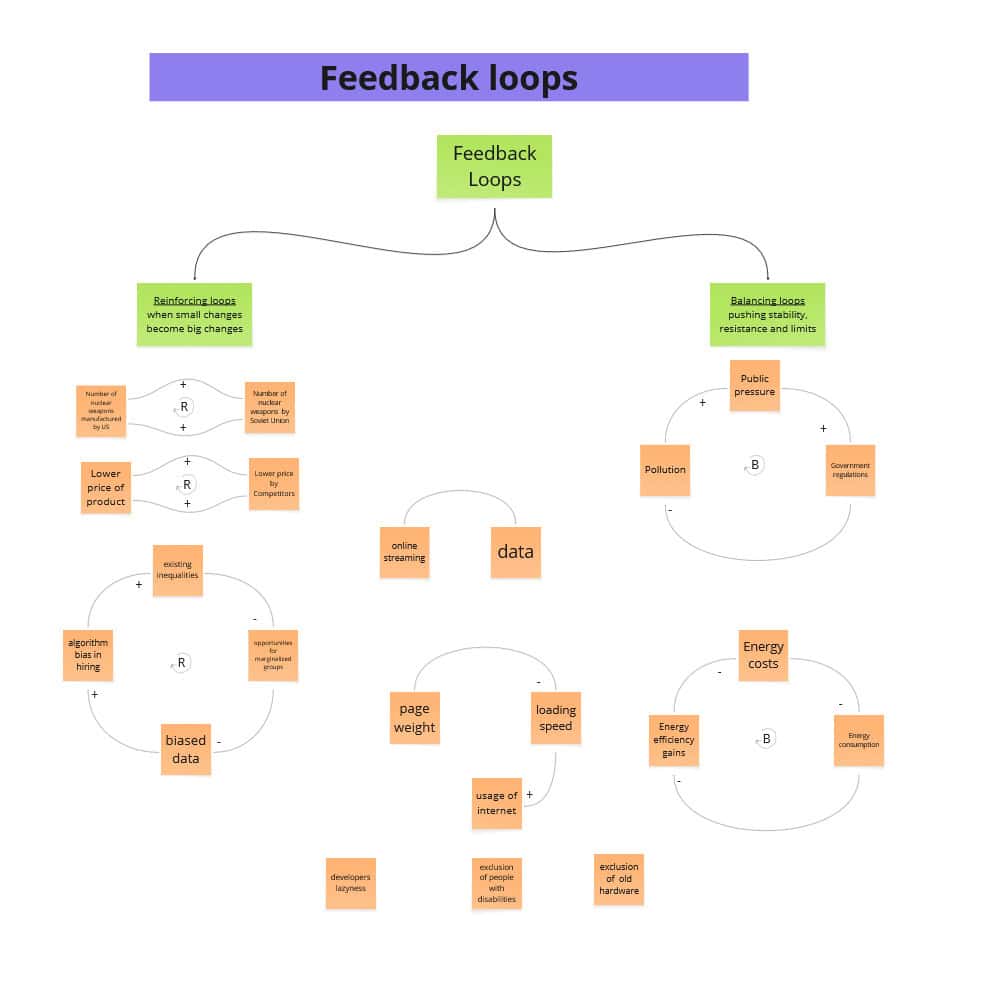
Our primary objective in this session was to map the current reality using a causal loop diagram (CLD). Consequently, it was crucial for us to understand the two types of feedback loops in CLDs, namely reinforcing and balancing feedback loops. Reinforcing loops amplify change, leading to exponential growth or decline. For example, in a bank account, interest earned increases the balance, which then earns more interest, leading to exponential growth. Balancing loops counteract change, seeking stability and equilibrium. For example, a thermostat regulates temperature by turning the heater or air conditioner on or off to maintain a desired state.
If you would like to be a part of the next co-creation systems series, join the #systems-series channel on Slack.
Revisiting the basics of systems thinking
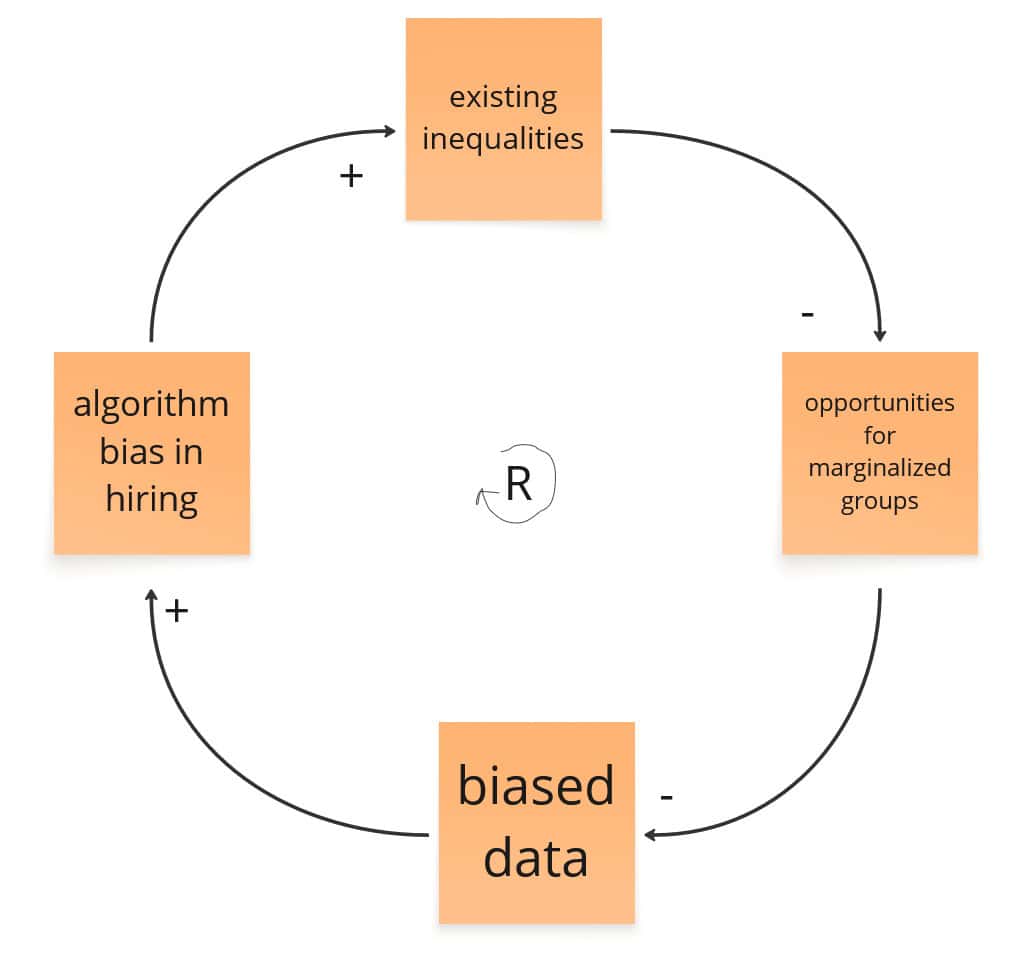
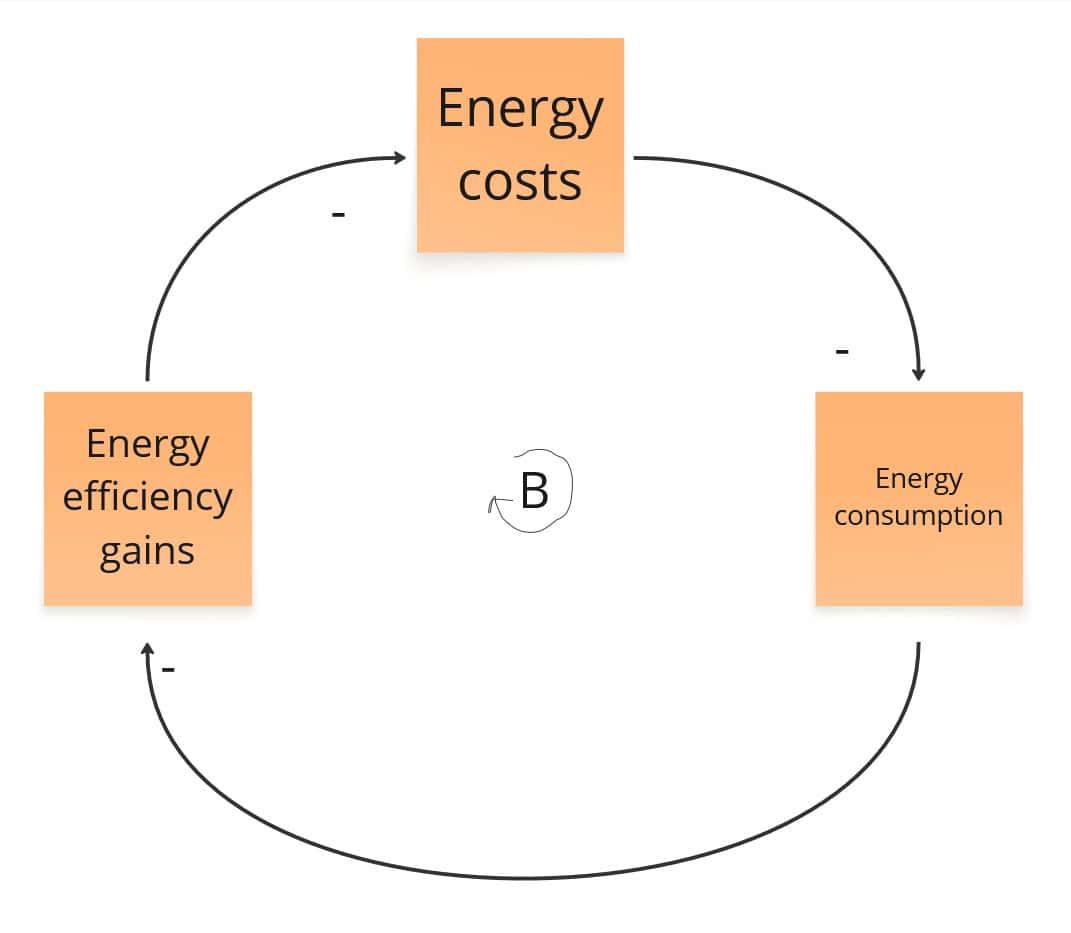
The best part of the CLDs is that they spark conversations. A participant noticed the Jevons paradox in balancing feedback loops, especially related to efficiency gains due to technological advances, which led to discussions around why one should be critical of efficiency gains. The CLDs showed us that improving efficiency doesn’t necessarily lead to reduced resource consumption; it often leads to increased consumption due to behavioral adaptation.
Systems change project example: Mindful integration of technology
To comprehensively understand the entire systems change process, we looked at an illustration of mindful technology development.
In system change projects, you begin with a vision statement. This illustration commenced with: ‘In 2035, individuals intentionally and mindfully integrate technology into their lives, prioritizing well-being, meaningful connection, and real-world engagement. Technology serves as a tool to enhance, not dominate, human experience.”
Next, you need a primary focus area to comprehend the current reality. For this illustration, we used “The increasing time spent online.”
From there, you use the iceberg model to organize the events, patterns, systems structures and the mental models relating to the focus area. Below is an example:
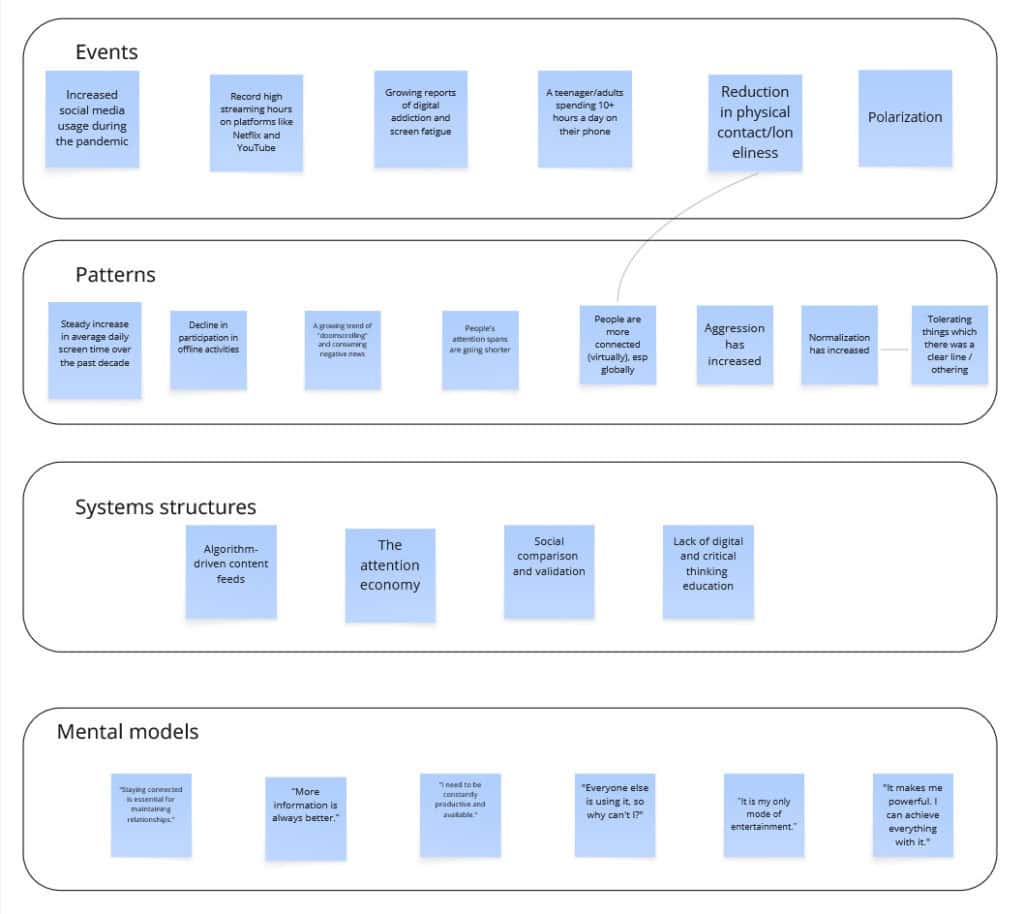
Causal loop diagram:
The iceberg model helps us to discover the key variables and relationships that should be included in a CLD. The CLD can then be used to model the dynamics of the system identified in the iceberg model, helping us to gain a deeper understanding of how the system works and where interventions might be most effective. We looked at a small CLD that represented one of the reasons and impacts of increase in the time spent online. It showed feedback loops which are repercussions of time spent online.
- Reduction in real world interactions leading to social isolation.
- Increase in consumption because of increase in exposure to targeted ads.
- Social isolation leading to depression, impacting the release of dopamine, leading to more time spent online to balance the dopamine, and algorithms taking advantage of this fact.
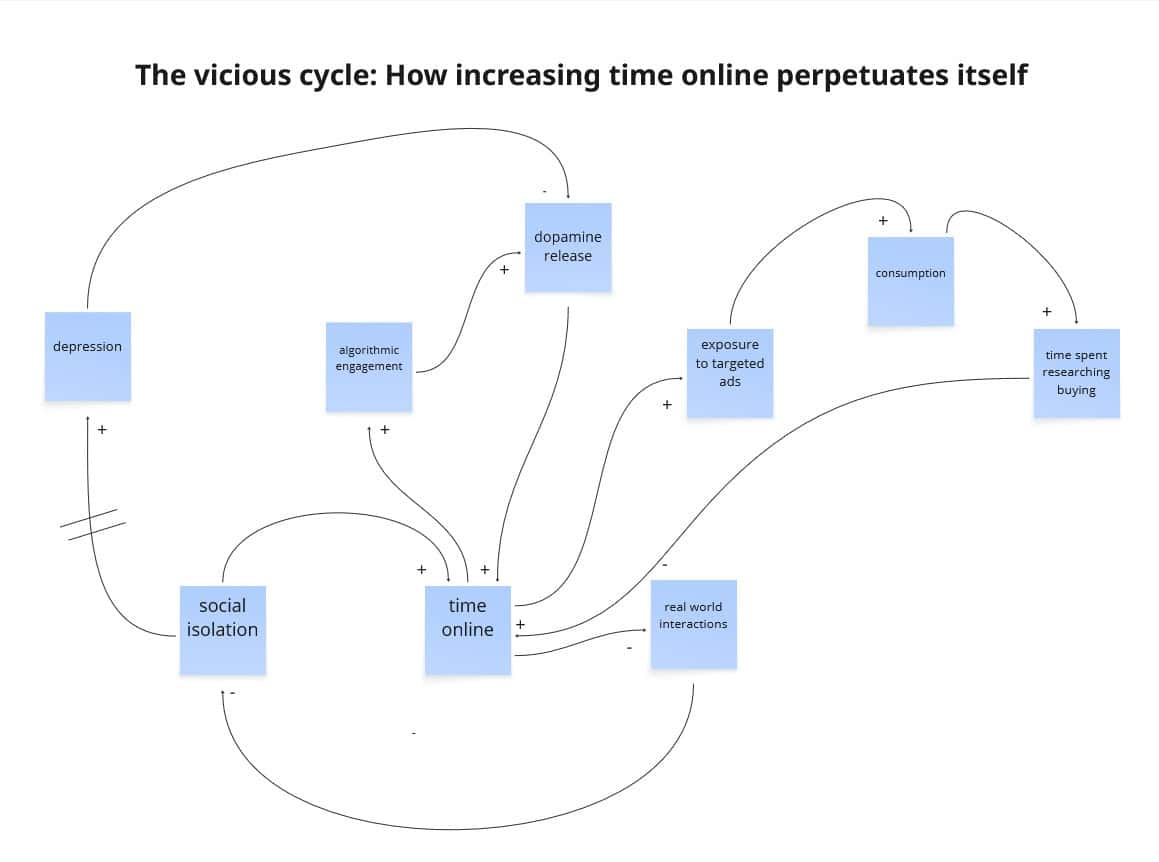
Identifying leverage points
We tried to understand how causal loop diagrams make the task of finding leverage points (small shifts in one thing can produce big changes in everything). To identify the leverage points, we looked at the feedback loops that were trying to perpetuate the problem or obstruct the goal. Since the iceberg model had already helped us to identify the mental models behind the feedback loops, we knew how to challenge them. The identified leverage points were:
- Redesigning social media platforms
- Digital literacy education
- Algorithmic transparency
- Promoting offline activities
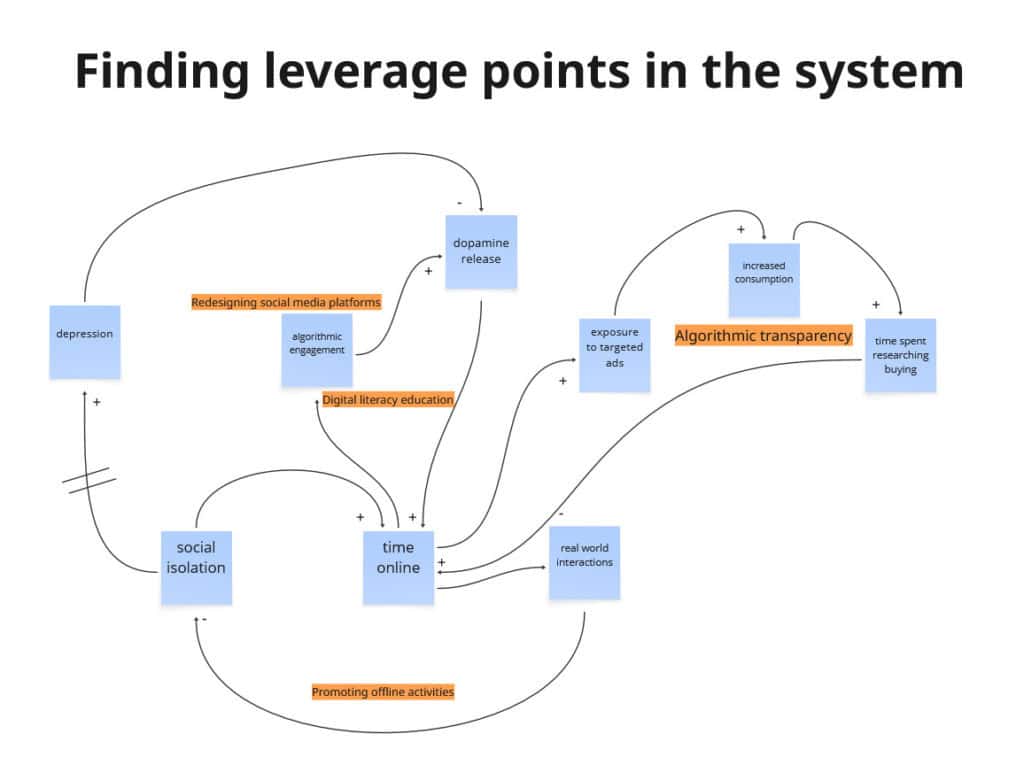
Intervention design
For each of the identified leverage points, we then looked at the possible fundamental interventions possible at a systemic level.
- Redesigning social media platforms
- Reduced notification frequency
- Prioritize meaningful interactions
- Ethical design standards
- Digital literacy education
- Public awareness campaigns
- Media literacy curriculum in Schools
- Train-the-trainer programs
- Algorithmic transparency
- Policy recommendations
- “Algorithm explainability” tool
- Nutrition labels for algorithms
- Promoting offline activities
- Community-based offline events
- Support for local businesses & organizations
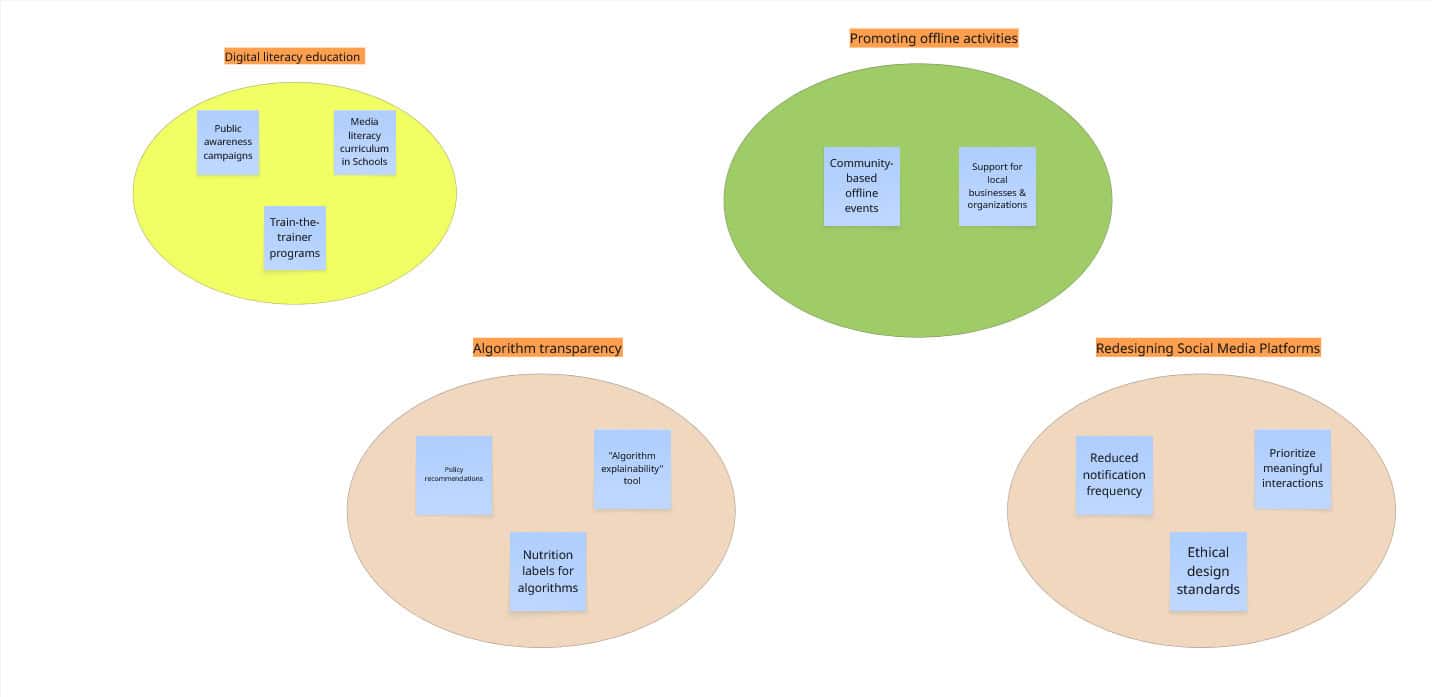
Systems change project activity: Technology as a catalyst for equity and well-being
For the second systems change project, we focused on the area, “Technology is not an enabler,” which we explored in Systems Series 2.
Together, we crafted a vision statement for this change project: “In 2035, technology is a powerful enabler for a thriving, prosperous society where our needs are met. Resources will be distributed equitably.”
Before we mapped the current reality with a CLD, we revisited the iceberg model we had previously developed in the second part of the series.
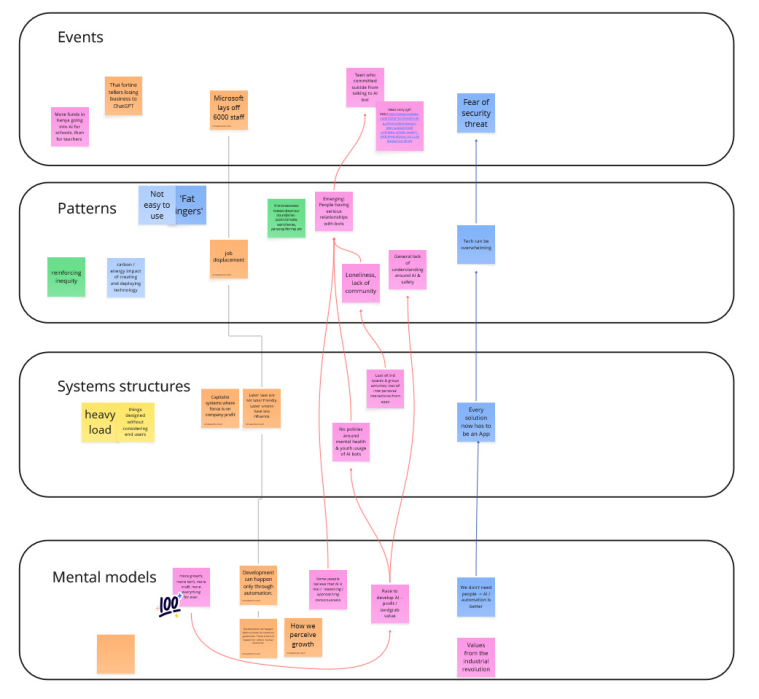
Causal loop diagram
Each participant drew their individual CLDs to convey their perception of a significant systems narrative underlying this focus area to convey their perception of a significant systems narrative underlying this focus area. This transformed into an engaging platform for discussing and collaborating on each other’s CLDs. The participants developed the following CLDs. For clarity, I have edited the CLDs for this blog post.
- The reinforcing feedback loop of web content creation and crawling thrives because of the rapid pace of creation and amplification through various tools and the integration of AI.
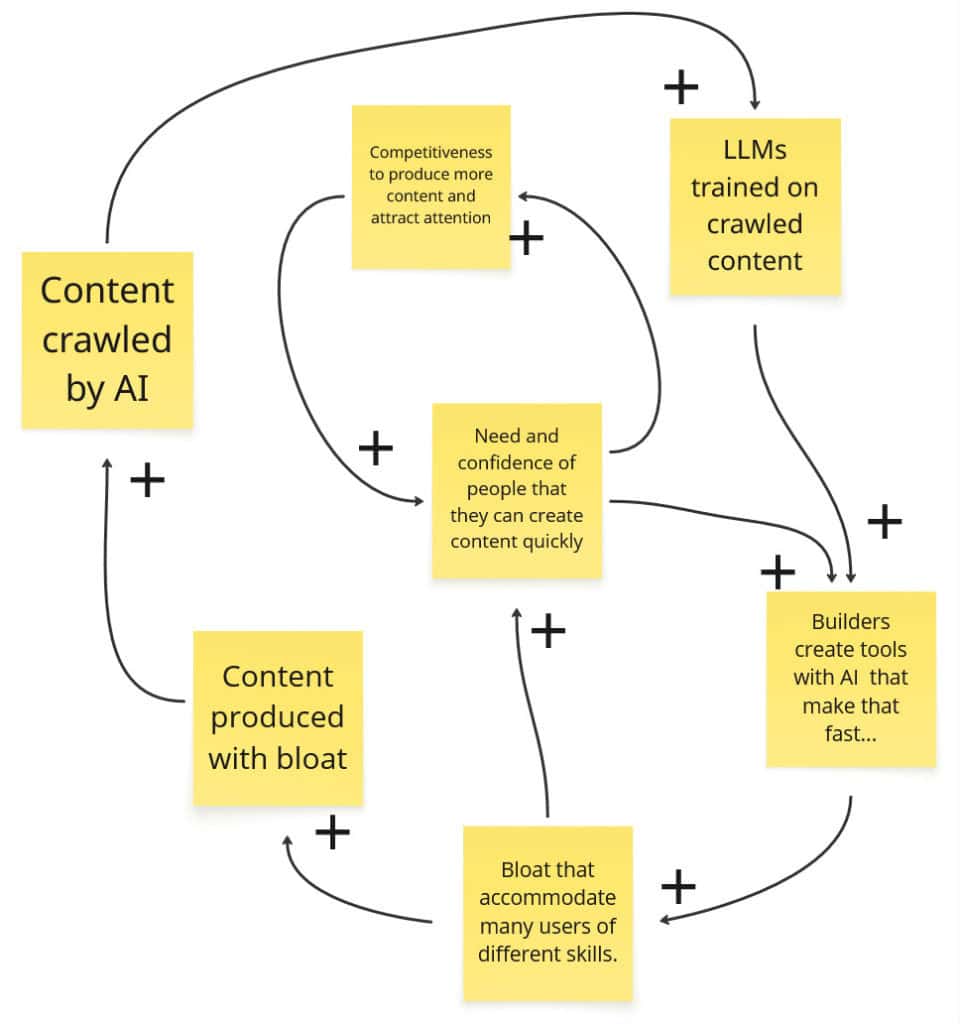
- Initially, bandwidth efficiency gains prompt web developers to progressively enhance the complexity of web pages, ultimately diminishing the observed bandwidth gains.
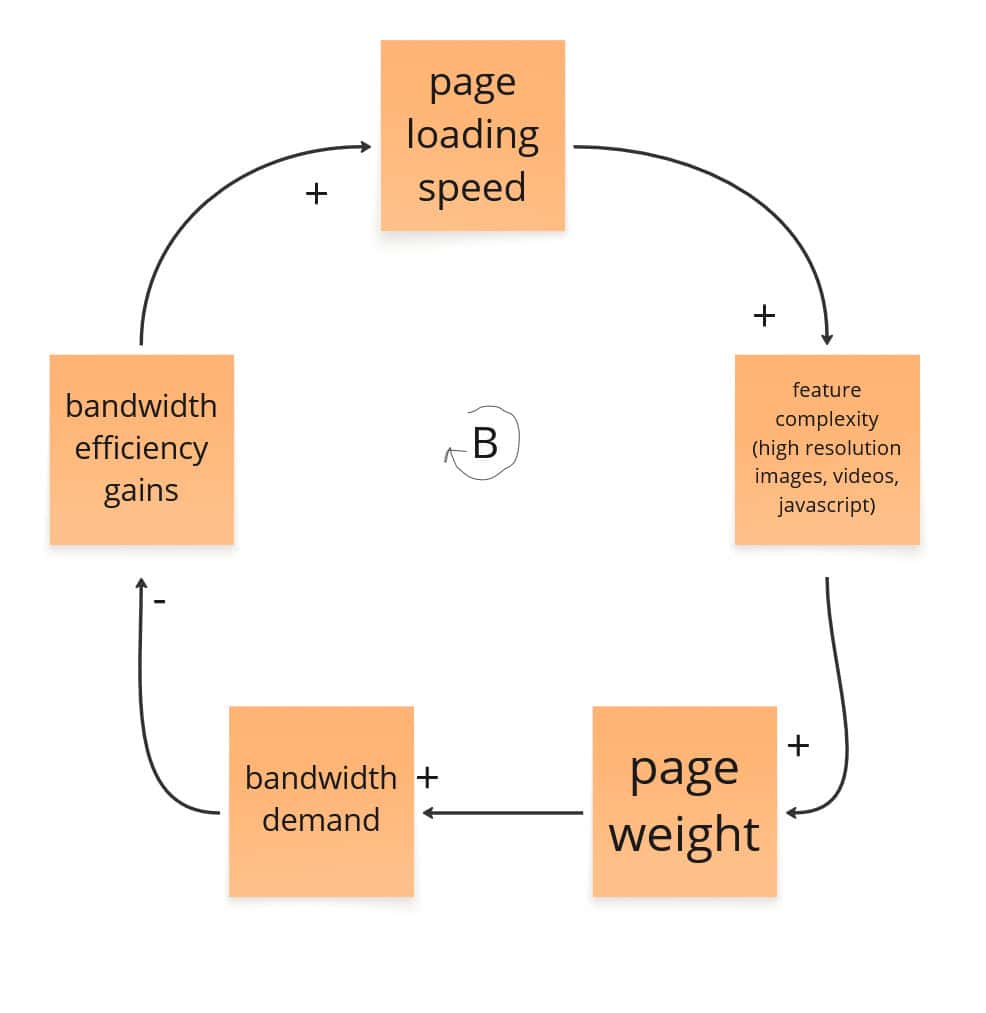
- Corporate lobbying hinders genuine social progress because it concentrates wealth in the hands of a select few powerful individuals who dictate the implementation of technology to further enhance their own power.
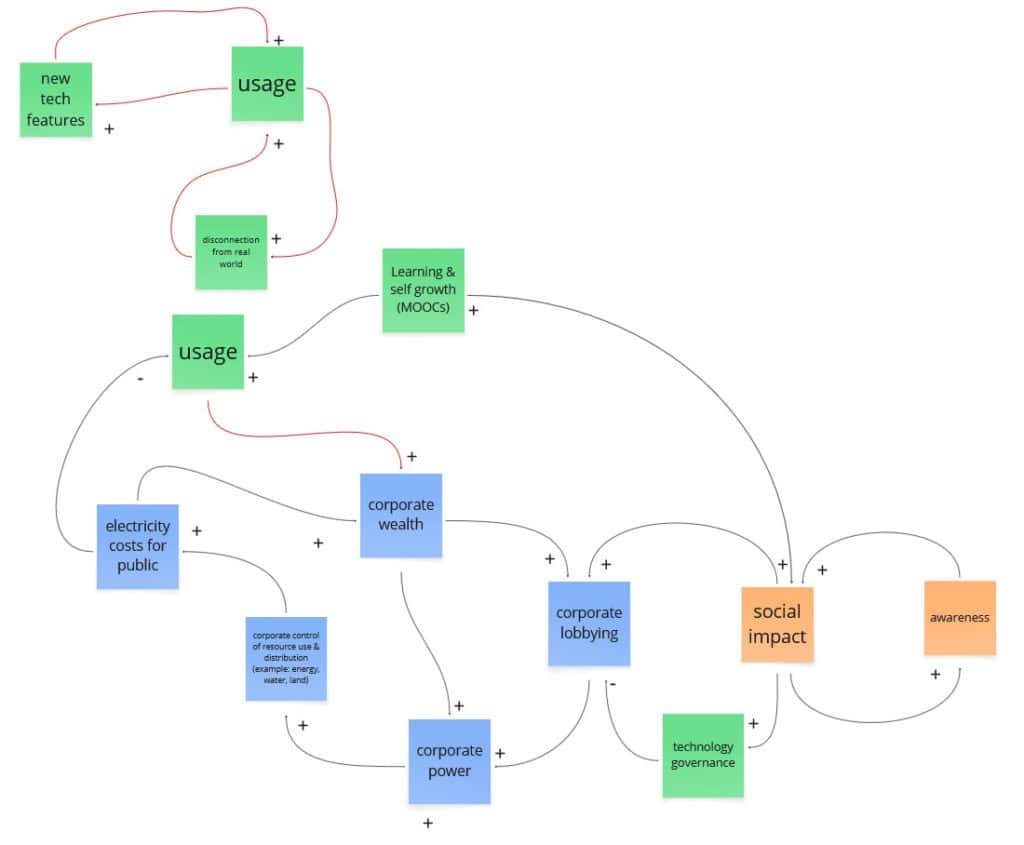
Designing fundamental interventions
Participants then brainstormed truly fundamental solutions based on the insights they gained from the CLDs.
Several fundamental solutions to enable technology were proposed:
- Enhancing transparency: Create transparency regarding the energy, water, and environmental impact of our actions.
- Implementing financial penalties: Utilize taxes, fines, and equity redistribution to address environmental concerns.
- Limit corporate political advertising: Establish policies that restrict corporate political advertising.
- Strengthen protections for public resources and utilities: Ensure robust safeguards for public resources and utilities.
- Promote digital and physical education: Provide comprehensive education programs that encompass both digital and physical learning experiences.
- Governments should lead by example: Governments should uphold principles and advocate for what is morally and ethically correct, challenging the practices of large corporations.
- Support marginalized communities through positive technology: Utilize technology to empower and support marginalized communities.
- Adopt sustainable approaches to content and code creation: Encourage conscious and intentional approaches to content and code creation.
- Implement positive governance frameworks: Establish governance frameworks that prioritize positive outcomes and environmental responsibility.
A key takeaway from the discussion was that people working in sustainability must demonstrate more confidence in their actions to bring about systemic change in how technology is designed.
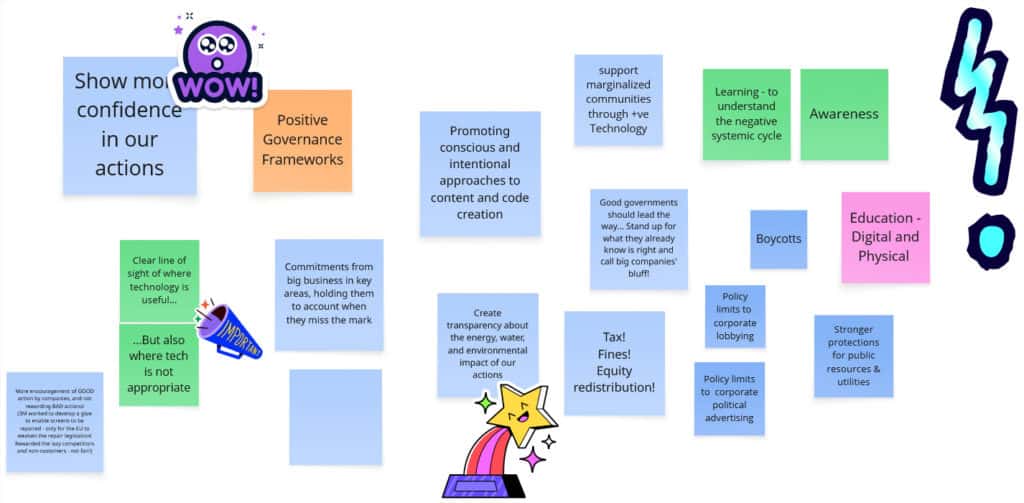
Systems Series Continues
During the series the systems change makers were successful in creating a shared vision for sustainable tech, mapping the current reality using causal loop diagrams and creating fundamental solutions to reduce the gap between the vision and current reality.
Co-creating the vision and the current reality gives us hope and drives us to do more fundamental and systemic work in tech. The three part systems series is just the beginning of a long journey. We’d love to continue this journey of co-creation in the CAT community. If you’re interested in hosting such co-creation journeys, just reach out to Siddhesh Wagle.
Acknowledgements: A special thank you to Jon Sleeper to co-create the workshop structure and co-facilitating. I would also like to express my sincere appreciation to Melissa Hsiung for her help with the series planning. I would also like to thank all the systems change makers for their valuable contributions.
References:
The workshop is designed using the following books
- Thinking in Systems by Donella Meadows
- The Fifth Discipline by Peter Senge
- Systems Thinking for Social Change by David Peter Stroh
